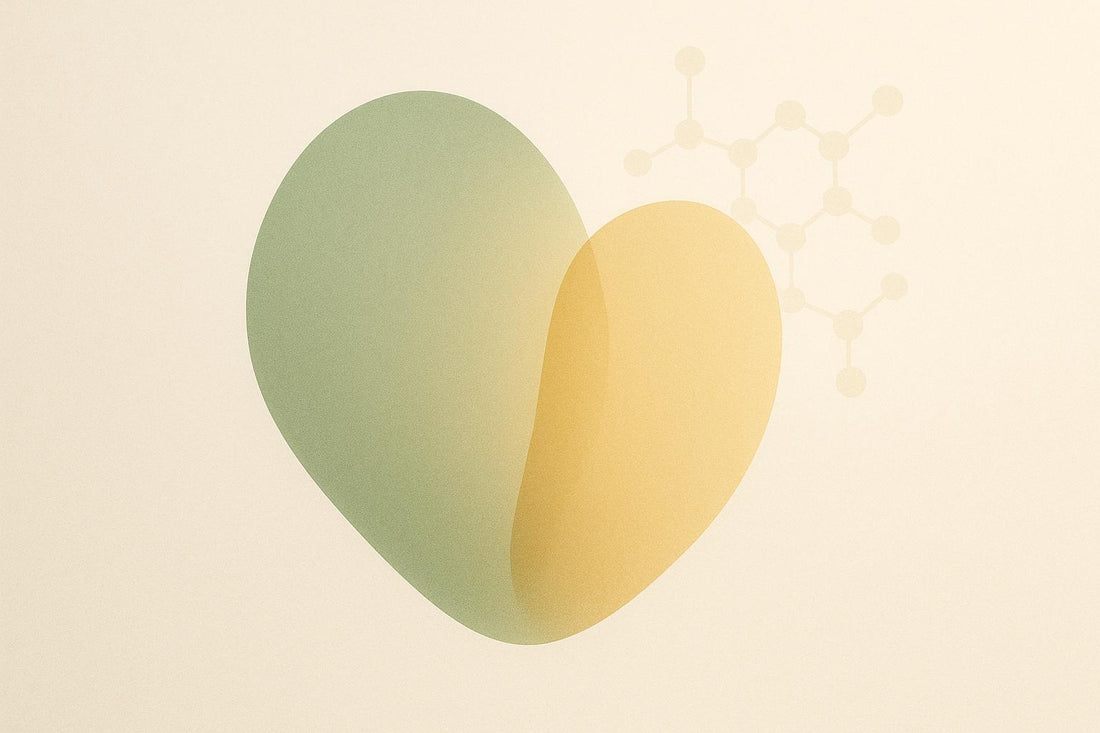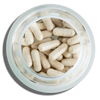Polyphenols, found in foods like blueberries, green tea, and dark chocolate, are linked to health benefits like reducing inflammation and chronic disease risks. However, they can interfere with medications by altering how drugs are metabolized, especially at high doses from supplements. Key risks include:
- Enzyme Interference: Polyphenols can inhibit liver enzymes (e.g., CYP3A4), affecting drug breakdown.
- Drug Absorption Issues: They may increase or decrease drug levels in the body.
- High-Risk Medications: Blood thinners (e.g., warfarin), heart drugs (e.g., statins), and antibiotics are particularly vulnerable.
What You Can Do:
- Space Out Doses: Take medications and supplements 1–3 hours apart.
- Consult Your Doctor: Share all supplements you're taking to avoid harmful interactions.
- Focus on Food: Stick to polyphenol-rich foods rather than high-dose supplements.
Think Twice Before Eating Blueberries on These Medications
How Polyphenols Interact with Drugs
Polyphenols, naturally occurring compounds found in many foods and supplements, can influence how medications work by altering drug metabolism. These interactions can either weaken a drug's effectiveness or raise its concentration to potentially harmful levels, making it crucial to consider their impact on treatment outcomes.
On average, people consume about 1 gram of polyphenols daily through their diet and supplements [3][6]. While this might not sound like much, these compounds are powerful enough to affect how the body processes medications. This explains why their effects can vary widely and why drug-specific recommendations are often necessary.
CYP450 Enzyme Changes
The liver's CYP450 enzyme system plays a key role in metabolizing medications, helping the body break them down for safe elimination. One enzyme in particular, CYP3A4, processes more than half of all drugs on the market [3][6]. Polyphenols can influence these enzymes in different ways - either speeding them up or slowing them down - depending on the specific compound involved [3].
Some polyphenols directly bind to these enzymes, while others affect their production [4][5]. For instance, resveratrol, a compound found in red wine and popular in longevity supplements, has been shown in lab studies to irreversibly inhibit CYP3A4, reducing its ability to metabolize certain drugs [3][6]. Similarly, flavonoids like quercetin, kaempferol, and galangin, as well as apigenin and chrysin from various plant-based foods, have demonstrated inhibitory effects. Since CYP3A enzymes in the small intestine make up about 80% of the body’s total P450 content, this area becomes a critical site for polyphenol-drug interactions immediately after ingestion [3][6].
P-glycoprotein Transporter Effects
Polyphenols also affect P-glycoprotein transporters, proteins that regulate how drugs are absorbed and eliminated. These transporters are vital for medication absorption in the intestines and for elimination through the kidneys and liver. When polyphenols alter their function, it can lead to drugs accumulating in unintended areas or failing to reach their intended targets, complicating treatment outcomes even further.
Combined or Opposing Effects
Interactions between polyphenols and drugs can get even more complex when multiple mechanisms are at play. For instance, apple juice has been shown to reduce the bloodstream concentration (AUC) of fexofenadine, making the drug less effective [7]. On the other hand, cranberry juice increased the exposure of nifedipine by about 1.6 times, which could amplify the drug's blood pressure-lowering effects. Similarly, EGCG, a compound in green tea, increased verapamil levels by 74.3% to 111%, more than doubling the drug’s impact.
Other examples highlight the variability of these interactions. Curcumin, when taken with the heart medication talinolol, reduced the drug's AUC by about 33% (from 1,860.0 to 1,246.0 ng·h/mL) [7]. Meanwhile, quercetin decreased cyclosporine levels by 67.8%, a concerning issue for transplant patients who rely on cyclosporine to prevent organ rejection. Timing and dosage also play a huge role. For example, St. John’s wort increased fexofenadine levels by 45% after a single dose but reduced them by 35% with long-term use [7]. This demonstrates how the same polyphenol can have opposite effects depending on how it’s used.
High-dose supplements can intensify these unpredictable effects, making it even more important to understand and manage these interactions. Careful consideration of timing, dosage, and individual factors is essential to keep medications both safe and effective.
High-Risk Medications and Polyphenol Interactions
Some medications require extra care when taken alongside polyphenol supplements due to potential interactions that could affect drug efficacy or safety.
Blood Thinners (Warfarin)
A 2020 rat study revealed that resveratrol significantly increased the effects of warfarin. Specifically, it raised the exposure of R-warfarin and S-warfarin by 58.6% and 48.8%, respectively, while also boosting the INR (a measure of blood clotting) from 1.73 to 2.64 [8]. This happens because resveratrol inhibits CYP2C9 and blocks BCRP transporters, which leads to higher concentrations of warfarin in the body. If you're taking warfarin, it's crucial to let your doctor know about any resveratrol supplements. To minimize bleeding risks, it’s recommended to stop using resveratrol at least two weeks before any planned surgery [9].
Heart Medications (Statins)
Interactions between statins and polyphenols were observed in 83.9% of analyzed cases [10]. Many polyphenols, such as silymarin, scutellarin, naringin, baicalein, breviscapine, and EGCG from green tea, can inhibit key transporters like OATP1B1 and OATP2B1, as well as CYP3A4 enzymes. This can lead to increased statin levels, which raises the risk of muscle damage. For example, a clinical study found that quercetin increased both the overall exposure and peak concentration of pravastatin. While this might improve the drug's effectiveness, it also heightens the likelihood of side effects [10].
Antibiotics and Immune-Suppressing Drugs
Polyphenol interactions can also be a concern for antibiotics and immunosuppressants, especially since these drugs often have narrow therapeutic windows. Even small changes in how the body metabolizes or absorbs these medications can lead to serious outcomes, like treatment failure or toxicity. One case involved a transplant patient on tacrolimus who experienced elevated drug levels and toxicity while taking CBD [11]. Additionally, curcumin has been shown to inhibit efflux pumps - similar to the effects of verapamil and reserpine - which can alter drug concentrations [12].
Surveys suggest that 15% to 45% of patients use herbal supplements alongside their prescribed medications. This highlights the importance of discussing all supplement use with healthcare providers to avoid unintended drug interactions [11].
sbb-itb-4f17e23
How to Prevent Drug Interactions
Safely incorporating polyphenols into your routine while taking medications requires careful planning. By following these practical steps, you can reduce the risk of unwanted drug interactions.
Timing Your Doses
Space out your supplements and medications by 1–3 hours to minimize absorption issues and reduce the chances of interference [15]. This gap gives your body enough time to process each substance separately, preventing competition for the same enzymes and transporters.
For example, if you take heart medication at 8:00 a.m., wait until 11:00 a.m. or later to take your resveratrol supplement. This timing is especially critical for medications with narrow therapeutic windows, where even slight changes in absorption can impact their effectiveness.
Talk to Your Doctor
Many people forget to tell their healthcare providers about the supplements they use, but this step is essential. Always share the type, dosage, and frequency of your supplements so your doctor can evaluate potential interactions and adjust your treatment plan accordingly [13].
Be specific when discussing your polyphenol supplements. Let your provider know the exact products you're using. They can use trusted resources to assess any risks and make informed recommendations. As Lorraine Guyagon, author and expert, advises:
"Always consult a trusted healthcare professional to tailor your approach and ensure safe, effective use." - Lorraine Guyagon [14]
If your doctor is unfamiliar with a particular supplement, they can consult with specialists like clinical pharmacists or pharmacologists for additional insights [13]. Regular follow-ups help ensure your medications remain safe and effective over time.
Monitor and Adjust Doses
When combining supplements with certain medications - especially high-risk drugs like blood thinners - regular monitoring is crucial. Even minor changes in drug levels can lead to serious consequences. For instance, if you're taking a blood thinner like warfarin and decide to add a supplement such as resveratrol, your doctor may recommend more frequent blood tests to monitor your INR levels, which measure blood clotting.
Depending on test results, dose adjustments might be necessary. Your doctor could lower your medication dose to account for changes caused by the supplement or advise stopping the supplement entirely if the risks outweigh the benefits.
Healthcare professionals often recommend avoiding supplements when there’s limited data on potential herb-drug interactions [13]. This caution is particularly important for medications metabolized by enzymes like CYP2C9 or CYP2C19. In such cases, close monitoring for adverse effects or lab abnormalities is key [13]. With regular checkups and any needed adjustments, you can maintain a safe and effective treatment plan.
New Research and Future Directions
Emerging studies are shedding light on the dual nature of polyphenols - on one hand, they carry risks of interaction, but on the other, they show great potential for improving therapeutic outcomes. This is especially evident in cancer treatment, where polyphenols are being explored as tools to enhance the effectiveness of existing therapies.
Polyphenols as Treatment Helpers
Some polyphenols have shown promise in making cancer cells more sensitive to chemotherapy, a process known as chemosensitization. Take curcumin, for example - it’s been found to improve chemotherapy results across various cancer types. In lung cancer, curcumin helps overcome drug resistance by preventing the renewal of resistant cancer cells. In colon cancer, it works by altering glutamine metabolism to suppress cisplatin-resistant cells. Meanwhile, in liver cancer, curcumin disrupts tumor-promoting microRNAs, further enhancing treatment efficacy.
One challenge with polyphenols is their low absorption in the body, but scientists are tackling this issue with innovative delivery methods. For instance, Lee and colleagues developed a dry powder inhaler that delivers curcumin alongside paclitaxel. This combination showed a stronger effect against lung cancer cells than either treatment used alone.
However, it’s not all straightforward. While many polyphenols enhance the effectiveness of chemotherapy, others can interfere with treatments, potentially reducing their impact. This complexity underscores the importance of understanding polyphenol metabolism and interactions before incorporating them into therapeutic regimens.
Why Interactions Are Hard to Predict
One of the biggest hurdles in understanding polyphenol interactions lies in the variability of the gut microbiome. The trillions of bacteria in your digestive system play a key role in breaking down polyphenols into metabolites, and this process differs significantly from person to person.
For example, some individuals can convert soy isoflavones into equol, a compound linked to various health benefits. These individuals are known as "producers", while those who lack the necessary gut bacteria are "non-producers." Similarly, with ellagitannins found in foods like pomegranates and berries, people produce different urolithin metabolites depending on their gut microbiota.
This variability isn’t limited to the microbiome. Factors like diet, genetics, and the environment also influence how polyphenols are metabolized. As a result, two individuals taking the same polyphenol supplement alongside similar medications might experience completely different effects.
To address these challenges, researchers are exploring personalized approaches. By analyzing gut bacteria composition and genetic markers, scientists aim to predict how individuals will respond to polyphenols. While this research is promising, these methods are still in the early stages and have yet to become part of standard clinical practice.
Weighing Benefits and Risks
Using polyphenols alongside medications presents a mix of benefits and risks. These plant-derived compounds are linked to various health perks, but they can also interact with certain medications, making it essential to approach their use thoughtfully.
For example, high polyphenol intake has been associated with a 57% reduction in the risk of type 2 diabetes over a period of 2–4 years [1]. However, there are potential downsides. Consuming 100–400 mg of polyphenols per serving can reduce iron absorption by 60–90% - a critical concern for individuals with iron deficiencies or those on iron supplements [2].
Another important factor is that polyphenol supplements don’t contain the additional nutrients and compounds found in whole foods. Plus, there’s no established guideline for safe dosages [1]. For individuals on prescription medications, this can be tricky. While drug interactions with polyphenols are uncommon, when they do occur, the effects can be serious. That’s why many healthcare professionals recommend focusing on polyphenol-rich foods - like apples, berries, olive oil, and turmeric - rather than relying on supplements [16].
It’s always smart to discuss supplement use with your doctor. Many patients appreciate when their healthcare providers bring up the topic of supplements, as it helps ensure any potential interactions are carefully managed. This is especially important because the polyphenol content in foods can vary greatly depending on factors like where the food was grown, how ripe it is, and how it was stored or prepared [1]. By sticking to a diet rich in plant-based foods, you can enjoy the benefits of polyphenols while minimizing risks.
Ultimately, your decision should consider your health needs, current medications, and comfort with potential risks. For most people, getting polyphenols from a diverse, plant-heavy diet is the safest and most effective option. If you’re thinking about adding supplements - especially if you have specific nutrient deficiencies or take medications with narrow therapeutic ranges - consult your doctor first.
FAQs
Can I take polyphenol supplements if I'm on prescription medication?
If you're on prescription medications, it's crucial to talk to your healthcare provider before incorporating polyphenol supplements into your regimen. These supplements can interact with certain drugs, including blood thinners and antibiotics, which might alter their effectiveness or increase the chance of side effects. For instance, some polyphenols can interfere with enzymes like CYP3A4, an enzyme that plays a significant role in breaking down medications in the body.
To minimize potential issues, your doctor might suggest adjusting when you take your supplements or keeping an eye out for any unusual reactions. Always stick to their guidance and let them know immediately if you experience any side effects while combining polyphenol supplements with your medications.
What are the warning signs of a drug interaction with polyphenols?
Drug interactions involving polyphenols can sometimes result in noticeable side effects, depending on the medication. For instance, pairing polyphenols with blood thinners may heighten the risk of bleeding, lead to unexpected bruising, or cause dizziness. On the other hand, when taken with antibiotics, these interactions might lower the drug’s effectiveness or trigger stomach issues.
If you experience any unusual symptoms while using medications alongside polyphenol-rich foods or supplements, it’s important to reach out to your healthcare provider. They can help ensure your treatment remains both safe and effective.
What foods or drinks should I avoid while taking medications to reduce the risk of polyphenol-related interactions?
Certain foods and drinks packed with polyphenols might interfere with how your body processes medications, potentially changing how well they work or increasing the risk of side effects. For instance, the polyphenols found in red wine, tea, and fruits like apples and berries can block the enzyme CYP3A4, which is crucial for breaking down many medicines. This can result in higher-than-expected levels of the medication in your bloodstream.
Polyphenols can also hinder the absorption of non-heme iron, which could be a concern if you're on medications that impact iron levels. To avoid complications, talk to your healthcare provider about any dietary adjustments you might need while taking medication, including whether you should limit foods and beverages high in polyphenols.




